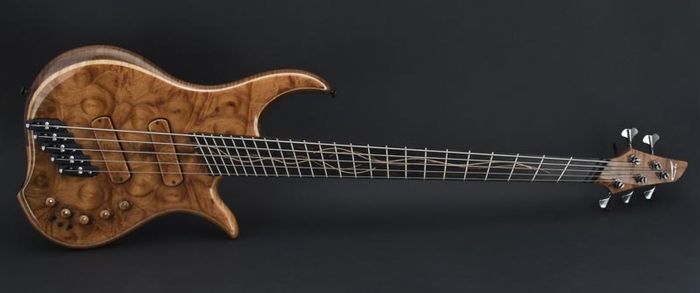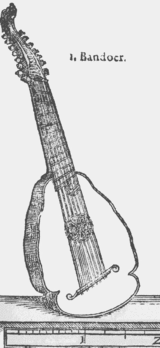- Multi-scale fingerboard
-
A Multi-scale fingerboard is an instrument fretboard which incorporates multiple scale lengths. The scale length (often simply but confusingly called the scale) is the vibrating length of the strings.
Guitars and Basses generally employ a single scale length for all of the instrument's strings, though the employed scale length varies significantly from maker to maker (electric guitar scale typically falls between 24" and 25.5"). This measure is the effective length of each of the vibrating strings, not counting compensation for adjusting intonation.
A multi-scale fingerboard or fretboard typically employs two scales, but could potentially incorporate more. The most typical use is one (long) scale length for the low string and a different, usually shorter, scale for the highest string. This could be achieved by angling the nut, and bridge, and fanning the frets.
The potential advantage is that one can obtain the power, especially in the bass, of a long scale, along with the sweetness and lack of twang of the shorter scale. For example, comparing the Martin D-28 with the Gibson J-45, the Martin has more power, the Gibson is sweeter.
Contents
History
The Bandora is a late 16th century instrument with a longer string length for its bass strings than for its trebles. It is depicted in Praetorius' music dictionary Syntagma Musicum published in 1619.
The concept of the Multiscale fingerboard goes back to at least 1900, when the first patent for such a fingerboard was filed by E. A. Edgren. (Patent #652-353, E. A. Edgren)
In his 1900 patent Edgren describes in his claims: “… a musical instrument the combination with a sounding body or box, of the following instrumentalities, to wit: a neck approximately in the form of a double convex in cross section... …”a plurality of frets secured to said neck, said frets being positioned at an angle one to the other so that the first and last frets incline in opposite directions... “...it will be noted that the bottom flange of the head C runs at an angle so that one side of the neck B will be longer than the side opposite. The frets diverge, running from the center outward, so that the lower frets extend slightly in a direction opposite to the upper frets.” This patent is no longer in force. When it was, it affected only instruments with a curved fingerboard, such as most steel-string guitars.
Possibly the first modern multiscale fretboard was used on an instrument called a StarrBoard, invented by John D. Starrett in 1977. Starrett developed a tapping instrument that employs a matrix of halftones, fretted horizontally with strings spaced vertically, to allow one fingering to cover all scales. Because of the large range of notes from low B below E on a bass, to high B four octaves above, however, he needed a way to have a long scale for the low B, but a shorter scale for the high B. He simply laid out the two scales he thought would work and connected the dots.
In 1989 Ralph Novak patented an arrangement of frets he calls “fanned frets,” denoting "a series of straight frets aligned in a non-parallel pattern," and "each of said frets extending along a straight line" and "with said plurality of strings substantially converging to a point." This patent has expired. Novak also has a copyright on the use of the term “fanned frets.” (Patent #4,852,450, Novak)
 An example of a multi-scale bass guitar with fanned frets. The instrument is a "Dingwall Prima Artist", made in Saskatoon (Canada) by Sheldon Dingwall. http://www.dingwallguitars.com/
An example of a multi-scale bass guitar with fanned frets. The instrument is a "Dingwall Prima Artist", made in Saskatoon (Canada) by Sheldon Dingwall. http://www.dingwallguitars.com/
References
See also
- Bandora (instrument);
- Orpharion, another early modern instrument, similar to the bandora;
- Charlie Hunter, an American jazz guitarist who has performed and recorded with a “fanned-fretted,” eight-string electric guitar built by Ralph Novak;
- Jean Baudin of the band Nuclear Rabbit plays nine and eleven string bass guitars which feature fanned frets;
- Brahms guitar, an eight-string classical guitar with slanted frets, originally developed by guitarist Paul Galbraith and luthier David Rubio.
- Neon (song), a song by blues-rock artist John Mayer.
External links
- United States Patent Office
- A calculator to calculate fret locations for a multiscale fretboard can be found on the Calculating Fret Positions page of the Liutaio Mottola Lutherie Information Website.
Categories:- Guitar parts and accessories
Wikimedia Foundation. 2010.

